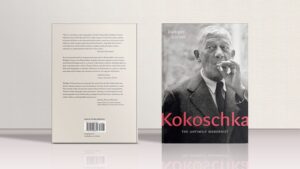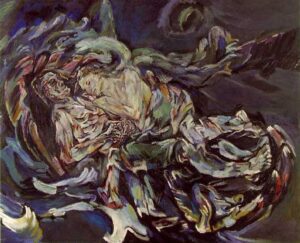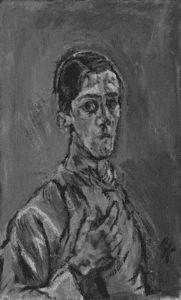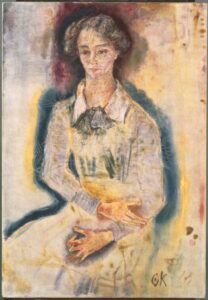Christian Hain

There are many ways to write a biography, and different reasons for reading one. At the beginning of his comprehensive work on Austrian artist Oskar Kokoschka (1886-1980), Rüdiger Görner, German professor at London University, touches upon the difficulties in painting any ‘true’ portrait in written form, or for that matter a ‘painted’ one. Kokoschka himself admitted that his autobiography “contained part real, part imaginary events and anecdotes” – but then again, whose life doesn’t? It won’t diminish the book’s artistic merits, nor tarnish its ‘truthfulness’ in a literary sense. The artist, by the way, might have chosen the title Mein Leben (My Life) to indirectly quote – and contradict – a certain other book infamously called Mein Kampf (My Fight/Struggle). Kokoschka, we learn, felt guilty for entering Vienna’s School of Decorative Arts in the same year that the other candidate was rejected who subsequently chose the career path of murderous tyrant. But today, we shall be concerned with Rüdiger Görner, and his characterisation of the artist as an “Untimely Modernist”.
A third-person narrator of any famed individual’s life will make decisions and, just like an artist painting a portrait, he may use – even abuse – the sitter to communicate views of his own, and tell (if only subconsciously) mostly about his own place and time, or, on the other hand, stay as close to ‘truth’ as is humanly possible. Trivially spoken, staying true to a character gets more and more difficult with the passing of time, yet personal acquaintance with the subject may influence the outcome just as well for the good as for the bad.
Oskar Kokoschka loved to have his photograph taken, but in his paintings sought to see beyond the face, and to unmask those who subjected themselves to his art. Quoting him on the occasion of a portrait done after the death mask of a catholic priest who was to be canonised: “How do I breathe life into the ashes, that this mask becomes a face again?”, Mr Görner adds: “What Kokoschka also brought back to life in this ‘portrait’ were unmistakably his own facial features.” (p.198) Is every portrait partly a self portrait?
It also needs to be said that a most faithful biography offering the truth, and nothing but the truth, holds less interest for the amateur reader: an encyclopedia article will only ever satisfy his appetite for facts with no added entertainment value. A mere recording of indisputable facts appears best suited for academic literature; regularly revised and updated, it often proves tiresome to read. On the other end of the spectrum (not caring about trivial ‘historicizing novels’ here), through fictional, albeit not purely made up works of literature, that might be all the ‘truer’ – think of Heinrich Mann’s Henry IV or Robert Graves’ I, Claudius, etc. Even that behemoth, Boswell’s Life of Johnson today appears as a mix between minute truthfulness, the author’s interventions and mere hearsay. Contrary to purely functional texts, these have everlasting value at least equal to their respective subjects. Somewhere in the middle, we find entertaining portraits of a historical person written after the latest fashion, well-adapted to the style and ideology du jour, and catering to the target audience’s interests, tastes, and manners. RG’s painting of OK (Görner likes these abbreviations a lot as Oskar signed his paintings OK, and we’ll just follow his example) is smartly written, but not so much a work of art itself: a portrait of Kokoschka is not a portrait of Kokoschka’s.
A German scholar writing about an Austrian artist, this might not sound too promising to the foreign reader, but just like his biographer, Kokoschka spent considerable time in the UK, and Görner dedicates many pages to that period, to art, politics, intrigue, and acquaintances the artist made. He paints a multifaceted image of Kokoschka as a person who was always en route and hardly ever arriving, travelling and “schooling his vision” around the world, though with some constancies nevertheless, for example lifelong obsessions with the 17th-century humanist Comenius, and women (one, Alma, towering above all!).
For Rüdiger Görner, Kokoschka was more than an ‘ok’ artist; the author can in good conscience be called a fan, as becomes evident in the introduction when he claims: “Kokoschka was – arguably – the greatest portraitist of the 20th Century”, continuing to compare “his easel and canvas [to] Freud’s couch”, and readers might think of Lucian F. among others also competing for that title. Calling Windsbraut (Bride of Wind) “one of the greatest paintings of the 20th Century”, doesn’t sound much like an impartial observer, either. As Görner states himself with regard to Kokoschka and his affairs: “There’s a fine line between love and hate, and we must probably hold his admiration responsible for certain emotional outbursts, calling the Alma doll – we’ll come to it shortly – “dismal”; or judging some politically (very) incorrect quotes “idiocies” (they might well have been that in their colloquial antisemitism, but still…). Then again, that’s what a portraitist often does, placing himself above the sitter, judging him from a contemporary point of view and his proper morals, not the ones that person was subjected to, particularly if it’s a posthumous portrait.

(Image: Wiki commons)
Mr Görner knows has a lot to say about the eminent people Kokoschka met in his lifetime, a Who’s Who of writers, composers and politicians; he further shines light on a side of Kokoschka that seems almost forgotten today: the painter as a writer of plays and stories himself. OK’s literary oeuvre takes about as much space as the paintings for which he is so much more, if not solely, remembered. Yet Görner takes care to differentiate the writing painter – or painting writer – from other multidisciplinary artists, in particular another ‘hun’ who also passed the wartime years in the UK: Kurt Schwitters. Kokoschka did not want to mingle different genres, not to create a ‘total work of art’ like Schwitters did, rather he was a ‘total artist’.
The preliminary outline sketch is followed by initially conventional biography: the artist’s birth in rural Austria, his family background, the move to Vienna, studies and first success, scandals, etc. But soon Görner interweaves this linear storytelling with a maelstrom of colourful impressions and episodes, jumping forth and back in time, quite early going into medias res – or media vita – the artist at 50, then back to the 1910s again, Berlin, Vienna, Prague, enfant terrible, darling of the upper class, starving bohemian, the reader can not necessarily keep track of all the where and whenabouts. There are, however, certain leitmotifs holding the book together, one of them being the School of Seeing, mentioned early on for the first time (call it ‘Chekhov’s Gun’, if you like), and then again and again. Sadly, the chapter finally dedicated to this hobby horse of Kokoschka’s – encouraging individual ways to see the world, influenced by the premature school reformer and pacifist globalist Comenius as well as by philosophical empiricism – that the artist tried to put into practice at an advanced age when teaching at Vienna Summer School, cannot fully convince as the curriculum remains obscure. The (potentially) underlying thesis, that Kokoschka’s whole life and career could be perceived as ‘going to school’ without ever graduating, training his regard all life long, collecting and adding more and more (visual) knowledge to his oeuvre, seems more interesting.
A second, much foreshadowed episode concerns the ‘Alma doll’, that might or might not have been emblematic for Kokoschka’s attitude towards the fair sex. Like countless artists before and after him, the painter enjoyed himself as a womanizer, and would most certainly find himself harassed by antisocial media’s lynch mobs today – ‘hetoo’, society having moved on from accepting the human, all too human. Above all, and even the marriage to Olga if we believe his biographer, emphasised a lasting enchantment with Alma – it actually feels weird to read “Mahler-Gropius”, as was her status then, the lady in question being nowadays remembered as Alma Mahler-Werfel. Gustav Mahler (music) came first, then the Kokoschka interlude (painting), followed by Walther Gropius (architecture), and later Franz Werfel (writing). Somehow you get the notion that she misunderstood the concept of ‘art collecting’ (note: I once met a business-minded type of person who told me about his youthful endeavours to collect one girlfriend from every G7 nation; I’ll just leave this here). Years after the couple’s separation in 1914, Kokoschka ordered that doll from a professional puppet maker, providing him with most detailed instructions as to material and appearance. He was not a sculptor himself (and neither Ron Mueck nor John deAndrea existed yet even as preparatory sketches in their respective father’s mind), but he likened the project to Rubens’ portraits of his wife. Strangely, mentioning this, Mr Görner hardly investigates the artistic context any further, and instead limits himself to playing at psychoanalyst. It is remarkable, though: not satisfied with his proper ‘copies’, depictions of the beloved, the painter turned to another genre, admitting artistic defeat – or separating art and life for once. We further find the assumption, Kokoschka would not have been honest when writing in the final days of WWI. Why? When he had been preoccupied with geopolitics? Perhaps it caused him too much sorrow and inner turmoil? Could not this (even if it’s not documented in letters, precisely because of its importance to the artist) have gone hand in hand with some personal escapism, a doll’s house (or: ‘bed’) to avert his thoughts, not to have to think about the world that much? And why not both: obsession and distraction at the same time? It sounds more interesting than the supposed ‘objectification’ of a former partner alone.
Just to add here: In certain comments, Görner appears to misunderstand Kokoschka’s dreams of a “global matriarchy” replacing all warfaring nations. This of course only made sense as long as ‘woman’ existed as a socially created entity that thought, talked, acted, and indeed: was different to man – duality, not equality. Also by the way: “Kokoschka, who was robbed of fatherhood through abortion by Alma…” (p. 189) – this doesn’t sound very pc for a change!

Not by accident, certain chapter titles read like parts of an exhibition: “The Journey”, “Wartime Art”, “Exile in England” – even their contents occasionally resemble wall texts. Humble suggestion for that imaginary retrospective’s title: “A School of Seeing, OK?!” There’s one major difference to an actual exhibition, though: all pictures are missing (equivalent to a Corona ‘virtual show’ with bad network quality?). Depictions – even monochrome – would’ve been useful for the non-expert who isn’t able to summon every single work before his mental eye, let alone those among us who don’t even have a precise idea (/none at all) of the artist’s style… Certainly, there’s Google (and Bing, and DuckDuckGo, and Qwant …), but from time to time you’d love to actually see what the author is talking about, particularly in the later parts, when the hitherto avoided name dropping of artworks hits in full force.
It doesn’t require a connoisseur to savour this biography, yet some background information, or preparation, seems indispensable: Beside being familiar with 20th-century art, literature, and music, readers should have at least a general notion of German politics – could you tell, without hesitation, who Theodor Heuss was, or even Konrad Adenauer (being German, I couldn’t name more than a handful of British Prime Ministers, one of them being Winston C., obviously)? This also concerns the translators – footnotes maybe?
To put it differently: If you haven’t visited an OK exhibition in recent times (when exhibition spaces were still open), this might not be the book for you, it’s certainly not ‘Kokoschka for Dummies’!
Not having read the original text, the translation seems otherwise well done, with only few exceptions such as rendering ‘Hammel’ as ‘lamb’ in several titles of paintings (it’s an adult sheep, or ‘neutered adult ram’ to be precise), or ‘Seele’ as ‘spirit’ instead of ‘soul’, but this is mere nitpicking about a great example of biographical writing that offers a lot of interesting insights, anecdotes, and mostly refreshing interpretations. Rüdiger Görner is a thorough expert in all things Kokoschka, and his work is entertaining as it is knowledgeable. We’d love to see a production of Kokoschka’s Orpheus and Eurydice opera with the score of Ernst Krenek on stage one day!
Only occasionally this reader wishes Herr Görner had heeded the old advice, Si tacuisse, philosophus mansisses (if you had been silent, you would have remained a philosopher). While calling Jeremy Bentham, the founding father of utilitarianism, a “social utilitarist” merely sounds odd, the reference to Voltaire’s slogan in Candide about “the best of possible worlds” (p.190) suggests nobody’s ever told him it was not Voltaire speaking as himself, but a parody of Leibniz. And, more serious: “Kokoschka wanted to paint all Greats: Stalin, Truman, de Gaulle and Churchill.” We can be sure, every single one of the estimated 60 million victims of Stalinism would not put him first in line, and find much harsher words for this than “idiotic”.
Oskar Kokoschka lived through difficult times: wounded in World War 1, exiled in Number 2, he later also socialised with the ‘wrong ones’: people in art and culture whose past was not beyond reproach (thankfully, Görner abstains from judging his earlier admiration for Knut Hamsun in this light, the Norwegian writer being also labelled ‘problematic’ by some). Kokoschka’s own political views can best be described as ‘classical humanist’, formed after the example of his life-long idol Comenius. Görner stresses supposed leanings towards left-wing politics, comparable to Picasso – whom Kokoschka loathed – and as in the case of the Catalan, this should not be taken too seriously: many artists love the role of a champagne socialist, and Kokoschka never set foot behind the Iron Curtain, instead choosing his last – and in a certain sense first – permanent home on the shores of Lake Geneva: that’s Monte Carlo with cows.
As mentioned before, a certain kind of biography tends to cater to fashionable views, and please allow me some remarks concerning a line in Rüdiger Görner’s foreword to the English edition of his book: “once again, we find ourselves confronted with increasingly aggressive right-wing nationalism all across Europe”. That’s certainly correct, albeit incomplete: the independent thinker might remember another Germanophone scholar who lived and taught in London for large parts of his life, i.e. Sir Karl Popper, and his warnings that the open society is surrounded by enemies right and left. For reasons logically inherent to the ideology, collectivist materialism – whether it be socialism in its national (German) or international (Soviet) incarnation – will always be hostile to art, individual liberty, and cultural diversity (which is not the same as assimilation).
Görner even implicitly admits this in his statement, “The artist protests against collectivism through portraiture” (p197) – socialism and communism being of course the ultimate form of collectivism. Freedom of art and expression today appear no less threatened from ‘the left’ as from ‘the right’; only recently, the van Gogh Museum came under fire for acquiring a Degas nude: “the depiction of a woman made by a man” – now, isn’t it shocking…? Who cares about (by itself always ‘irrational’, ‘unscientific’, ‘human’) quality, when all art needs to bow before the new mass morals. But today’s morals are beyond all doubt, indisputable, and will hold true forever; only they have been granted by GOd or SCience – says every generation, ever.

The Phillips Collection, Washington, DC
(Image: Wiki commons)
Görner’s praise of art dealers and historians who supported female artists, climaxing in the assertion: “The dominance of the feminine in the work of that time (1912/13) results from Kokoschka’s realisation that woman as the bearer of new life has an unassailable advantage over man” (p55) likewise sounds very modern – an “untimely modernist” indeed. Now compare this to an earlier quote, and Görner paraphrasing the artist: “(Kokoschka) left himself in no doubt over the purpose of artwork (…) the ‘miracle’ of which ‘every young girl of the common people is capable at any time: to conjure a life out of nothing (…) That is why only women and artists have respect for life’ ” (p32). Sounds more like dualism, doesn’t it? Equalling (man’s) artistic creation (of art, culture, and society as alternative, yet no less ‘true’ realities) to biological creation.
Furthermore, we aren’t obliged to follow Kokoschka (and Görner) in his – perfectly understandable, given the historic background – utopian dreams of a “world without nations” that would effectively equal only one all-encompassing superstate without chance of escape for the individual, and the end of all living cultural diversity. After all, Kokoschka himself preferred Greek tragedies to the contemporary stage, and not by accident did those originate in a fractured landscape of independent (city) states, each holding its own against the others – comparable to the great epoch of ‘German’ art and thought that provided more favourites of Kokoschka’s: Goethe and von Kleist. One could well argue that 1914 – and, consequently, 1933 – started in 1871 with the surrender of numerous independent nation states to one powerful Germany. Dreams of unification are first and foremost dreams of the greatest power over the largest mass, and a patchwork of competing colours will always prove more creative than the monochrome shroud, no matter how many colours lie smothered underneath.
An Untimely Modernist, by Rüdiger Görner’, Haus Publishing, Debra Marmor (Translator), Herbert Danner (Translator) Hardback £15.32
Volume 35 no. 6 July/August 2021
